Tyne Bridge: Difference between revisions
| (One intermediate revision by the same user not shown) | |||
| Line 72: | Line 72: | ||
==Outside links== | ==Outside links== | ||
{{commons category|Tyne Bridge}} | {{commons category|Tyne Bridge}} | ||
*{{bridgesonthetyne}} | |||
* Databases: [http://www.bridgesonthetyne.co.uk Bridges On The Tyne], [http://www.engineering-timelines.com/scripts/engineeringItem.asp?id=28 Engineering Timelines], [http://sine.ncl.ac.uk/view_structure_information.asp?struct_id=1241 SINE] | * Databases: [http://www.bridgesonthetyne.co.uk Bridges On The Tyne], [http://www.engineering-timelines.com/scripts/engineeringItem.asp?id=28 Engineering Timelines], [http://sine.ncl.ac.uk/view_structure_information.asp?struct_id=1241 SINE] | ||
* Articles: [http://www.bbc.co.uk/insideout/northeast/series3/tyne_bridge_northeasthistory.shtml BBC Inside Out - Tyne Bridge] | * Articles: [http://www.bbc.co.uk/insideout/northeast/series3/tyne_bridge_northeasthistory.shtml BBC Inside Out - Tyne Bridge] | ||
| Line 81: | Line 82: | ||
* Photographs of Tyne Bridges: [http://www.peterloud.co.uk/photos/Newcastle/Nc_4.html Peter Loud] | * Photographs of Tyne Bridges: [http://www.peterloud.co.uk/photos/Newcastle/Nc_4.html Peter Loud] | ||
* Video: [http://www.bbc.co.uk/nationonfilm/topics/misc-work/tyne-bridge-construction-building.shtml BBC - Nation on Film] | * Video: [http://www.bbc.co.uk/nationonfilm/topics/misc-work/tyne-bridge-construction-building.shtml BBC - Nation on Film] | ||
{{Tyne bridges}} | |||
[[Category:Bridges in County Durham]] | [[Category:Bridges in County Durham]] | ||
[[Category:Bridges in Northumberland]] | [[Category:Bridges in Northumberland]] | ||
[[Category:Bridges across the River Tyne]] | |||
Latest revision as of 21:11, 25 August 2020
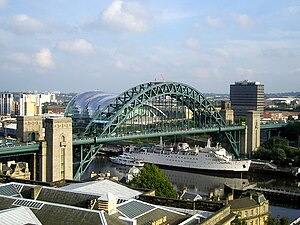
The Tyne Bridge is a through-arch bridge over the River Tyne linking Newcastle upon Tyne in Northumberland and Gateshead in County Durham. The Bridge was designed by the engineering firm Mott, Hay and Anderson,[1] who later designed the Forth Road Bridge and George Street Bridge in Newport, Monmouthshire. It was built by Dorman Long and Co. of Middlesbrough.[2] The bridge was officially opened on 10 October 1928 by King George V and has since become a defining symbol of Tyneside.
History of construction
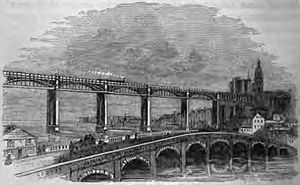
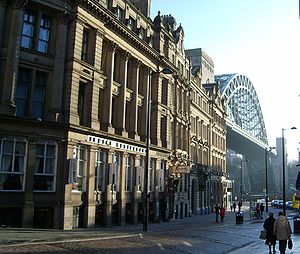
The earliest bridge across the Tyne, Pons Aelius, was built by the Romans near the location of the present Tyne Bridge. Built around AD 122,[3] it fell into disrepair. The next bridge built was one of stone in 1270. After 500 years, this was destroyed by the great flood of 1771. In 1781, a new stone bridge across the Tyne was completed. Increased shipping activity led to the stone bridge being removed in 1866 to make way for construction of the present Swing Bridge, which opened in 1876.
The idea for a bridge at the location of the present Tyne Bridge dates to 1864, due to concern about the cost of tolls on the High Level Bridge. The first serious discussions took place in 1883. Committees met over the next three decades, but it was not until the early 1920s that proposals were commenced in earnest, boosted by the chance to secure central government funding. On 29 April 1924, Newcastle and Gateshead approved the plans, and the Newcastle upon Tyne and Gateshead (Corporations) Bridge Act was passed on 7 August that year, with an estimated cost of £1 million including land acquisitions. The final cost on completion was £1.2 million.
Work started in August 1925 with Dorman Long acting as the building contractors. Despite the dangers of the building work, only one worker, Nathaniel Collins, a father of four and a local scaffolder from South Shields, died in the building of this structure.[4]
The Tyne Bridge was designed by Mott, Hay and Anderson, comparably to their Sydney Harbour Bridge version;[1] based on their earlier design on the Hell Gate Bridge in New York City (which was completed in 1916). The bridge was completed on 25 February 1928, and officially opened on 10 October by King George V and Queen Mary, who were the first to use the roadway, travelling in their Ascot landau. The opening ceremony was attended by 20,000 schoolchildren who had been given the day off. Movietone news recorded the speech given by the King.[5]
The Tyne Bridge's towers were built of Cornish granite and were designed by local architect Robert Burns Dick[1] as warehouses with five storeys. But, the inner floors of the warehouses in the bridge's towers were not completed and, as a result, the storage areas were never used. Lifts for passengers and goods were built in the towers to provide access to the Quayside; they are no longer in use.[6]
The bridge was originally painted green with special paint made by J. Dampney Co. of Gateshead. The same colours were used to paint the bridge in 2000. The bridge spans 531 ft and the road deck is 84 ft above the river level.
| Total length (includes approaches) | 1,276 ft |
| Length of main arch span (pier to pier) | 531 ft |
| Rise of arch (above pins) | 180 ft |
| Clear height (above high water level) | 85 ft |
| Total height (above high water level) | 194 ft |
| Width (bridge) | 56 ft |
| Width (approaches) | 79 ft |
| Total weight of steelwork (arch only) | 3,556 tons |
| Total weight of steelwork (including approaches) | 7,112 tons |
| Total number of rivets (including approaches) | 777,124 |
History of operations
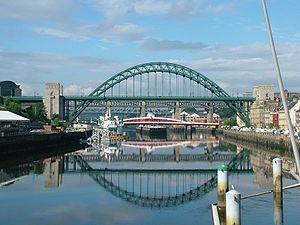
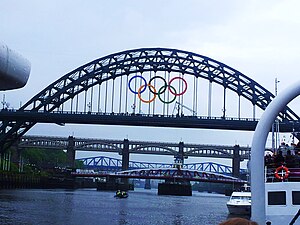
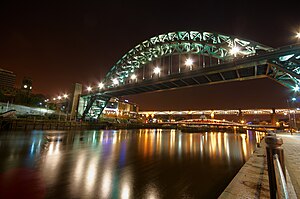
Tram lines were built into the Tyne Bridge structure and ready for immediate use after the opening ceremony in October 1928. Tram car No. 289 was the last Newcastle tram to run into Gateshead over the Tyne Bridge on Sunday 5 March 1950 at approximately 10.55 pm. The tram lines were subsequently removed, although some vestiges of these remain such as redundant fixings for overhead power lines.
Golden jubilee celebrations were held on 10 October 1978, when 1,000 balloons were released into the sky above the river to celebrate the anniversary of the Tyne Bridge. To mark the occasion, a cavalcade of vintage vehicles and a procession of people in period dress stopped traffic, re-creating the opening ceremony when King George V declared the bridge open in 1928.
Upon opening, the bridge carried the A1 Great North Road. Following the opening of the Tyne Tunnel in 1967, however, the A1 was diverted to the East and the road became the A6127. Following the construction of the Newcastle Western Bypass, the A1 moved again. The bridge was redesignated as the A167, which it remains today.
In 2012, the largest Olympic rings in the UK were erected on the bridge. The rings were manufactured by commercial signage specialists Signmaster ED Ltd of Kelso. The rings were over 80 ft wide and 40 ft tall and weighed in excess of four tons. This was in preparation for Newcastle hosting the Olympic football tournament, and the Olympic torch relay, in which Bear Grylls zipwired from the top of the arch, to Gateshead quayside.[7]
On 28 June 2012, a large lightning bolt struck the Tyne Bridge. It lit up the roads as the sky was very dark. The bolt, part of a super-cell thunderstorm, came with heavy rain - a month's worth of rainfall in just 2 hours - causing flash flooding on Tyneside.[8]
In 2015 Newcastle upon Tyne will be a host city for the Rugby World Cup.[9] Three matches will be played at St James Park, the home of Newcastle United Football Club.[10]
In recognition of Newcastle being a host city a large illuminated sign has been erected on Tyne Bridge.
References
- ↑ 1.0 1.1 1.2 Elwall, Robert. "Tyne Bridge". British Architectural Library. http://www.architecture.com/Explore/Buildings/TyneBridge.aspx. Retrieved 14 July 2014.
- ↑ "Dorman Long Historical Information". dormanlongtechnology.com. http://www.dormanlongtechnology.com/en/Dorman%20Long%20historical%20information.htm. Retrieved 14 July 2014.
- ↑ "Fact File:The Roman Tyne Bridge". twmuseum.org.uk. http://www.twmuseums.org.uk/discovery/buildingbridges/the-roman-tyne-bridge/. Retrieved 24 November 2014.
- ↑ Butcher, Joanne (1 March 2013). "85 years of the Tyne Bridge". chroniclelive.co.uk. http://www.chroniclelive.co.uk/news/local-news/85-years-tyne-bridge-crossing-1724495. Retrieved 14 July 2014.
- ↑ Butcher, Joanne (26 February 2013). "Bridge spans the generations". chroniclelive.co.uk. http://www.chroniclelive.co.uk/news/local-news/85-years-tyne-bridge-bridge-1724342. Retrieved 24 November 2014.
- ↑ "The Tyne Bridge". Bridges on the Tyne. 2006. http://www.bridgesonthetyne.co.uk/tynebri.html.
- ↑ "Olympic rings launched on Tyne Bridge". http://www.bbc.co.uk/news/uk-england-tyne-18432414. Retrieved 16 June 2012.
- ↑ Weather: record 110,000 lightning bolts strike during 'superstorms'
- ↑ http://www.rugbyworldcup.com/cities/newcastle/
- ↑ http://www.nufc.co.uk/page/Welcome//
Further reading
- Addyman, J. and Fawcett, B. The High Level Bridge and Newcastle Central Station: 150 Years Across the Tyne. By the North Eastern Railway Association for the High Level Bridge. 1999. ISBN 1-873513-28-3.
- Linsley, S. Spanning the Tyne: Building of the Tyne Bridge, 1925-28. Newcastle Libraries and Information Service, Newcastle City Council. 1998. ISBN 1-85795-009-7.
- Manders, F. & Potts, R. Crossing the Tyne. Tyne Bridge Publishing. 2001. ISBN 1-85795-121-2.
Outside links
| ("Wikimedia Commons" has material about Bridge Tyne Bridge) |
- Tyne Bridge: Bridges on the Tyne
- Databases: Bridges On The Tyne, Engineering Timelines, SINE
- Articles: BBC Inside Out - Tyne Bridge
- Images
- Historic photographs: Dorman Long collection, Pictures of Gateshead
- Aerial photographs: Britain from Above - aerial views of the bridge under construction and later in the 1930s, from the Aerofilms archive of English Heritage
- Panoramas: BBC
- Photographs of Tyne Bridges: Peter Loud
- Video: BBC - Nation on Film
| Bridges and crossings on the River Tyne | ||||||
|---|---|---|---|---|---|---|
| Metro Bridge | High Level Bridge | Swing Bridge | Tyne Bridge | Gateshead Millennium Bridge | Tyne Pedestrian Tunnel | Tyne Road Tunnels |
